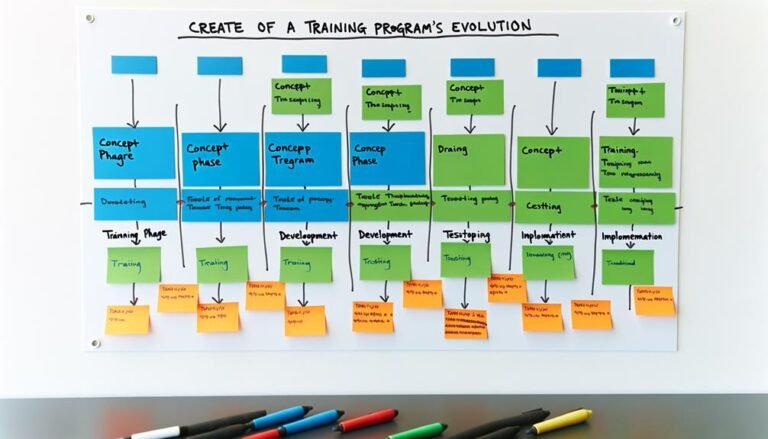Enhancing Learning Programs: A Comprehensive Evaluation Guide
In our exploration of enhancing learning programs, it's intriguing to note that studies have shown that organizations with well-structured evaluation processes are 30% more likely to see positive impacts on their training initiatives.
As we unravel the layers of comprehensive evaluation in this guide, we aim to equip you with practical strategies and insights to elevate your learning programs to new heights.
Stay tuned to discover how evaluation planning, data analysis, and stakeholder engagement can revolutionize the way you approach program enhancement and drive meaningful results.
Key Takeaways
- Align learning goals with organizational objectives for meaningful impact.
- Use evaluation results to enhance programs and drive continuous improvement.
- Engage stakeholders in data analysis and reporting for informed decision-making.
- Measure training success by evaluating knowledge, skills, and business contributions.
Evaluation Planning and Stakeholder Engagement
In planning evaluations and engaging stakeholders, it's crucial to meticulously outline the evaluation objectives and identify key individuals involved in the process. Stakeholder involvement plays a pivotal role in ensuring diverse perspectives are considered.
Timing considerations are equally essential, as aligning data collection with key program milestones can provide valuable insights. Engaging stakeholders early on allows for better collaboration and buy-in, fostering a more inclusive evaluation process.
Data Collection Methods and Tools
Meticulously outlining evaluation objectives and engaging stakeholders sets the foundation for selecting optimal data collection methods and tools for the evaluation process. When considering data collection methods, conducting a comparative analysis can help identify the most suitable approach for the specific evaluation needs.
Survey design plays a crucial role in gathering both quantitative and qualitative data effectively. By carefully crafting survey questions, ensuring clarity, and utilizing technology for efficient data collection, the evaluation process can yield valuable insights.
Consistency and reliability in data collection methods are essential to maintain the integrity of the evaluation results. Embracing innovative tools and techniques can streamline the data collection process, facilitating a more comprehensive analysis and interpretation of the gathered information.
Reporting and Data Analysis Techniques
Utilizing advanced data visualization techniques enhances the clarity and impact of our reporting and analysis in evaluating learning programs.
By effectively presenting data through visual aids such as charts, graphs, and dashboards, we can better identify patterns, trends, and outliers. This visual representation helps stakeholders grasp complex information quickly and facilitates the communication of key findings.
Through data visualization, we can draw meaningful conclusions that drive actionable insights for program improvement.
By transforming raw data into interactive visuals, we enhance stakeholder engagement and understanding, ultimately leading to more informed decision-making.
Embracing data visualization not only streamlines the reporting process but also elevates the quality and effectiveness of our evaluation efforts.
Program Enhancement Through Evaluation
Enhancing learning programs through thorough evaluation involves leveraging insights gained to drive continual improvement and adaptation for optimal effectiveness.
Continuous feedback is crucial in this process, allowing us to pinpoint areas for enhancement. By analyzing evaluation results, we can devise improvement strategies that align with organizational objectives.
It's essential to adjust learning programs based on evaluation feedback, implementing changes that enhance program effectiveness. Monitoring progress and iterating evaluation processes ensure that enhancements are sustained over time.
Through this iterative approach, we can fine-tune our programs to better meet the needs of learners and the organization as a whole.
Aligning Learning Goals With Organizational Objectives
To ensure the alignment of learning goals with organizational objectives, we must establish a clear and strategic connection between the two to drive overall success.
- Improvement Strategies:
- Regularly assess and adjust learning goals to meet evolving organizational needs.
- Goal Alignment Techniques:
- Ensure that learning objectives directly contribute to achieving the organization's mission.
- Feedback Mechanisms:
- Implement feedback loops to gauge the effectiveness of learning goals in supporting organizational objectives.
- Performance Metrics Integration:
- Incorporate key performance indicators to measure the impact of learning programs on organizational success.
Conclusion
In conclusion, by meticulously planning, strategically collecting data, engaging stakeholders, and continuously improving, we can enhance learning programs. Through aligning learning goals with organizational objectives, we ensure measurable outcomes and impactful results.
Utilizing evaluation insights, we drive program enhancements, foster skill development, and optimize training effectiveness. Let's embrace data-driven decision-making, cultivate a culture of continuous learning, and pave the way for transformative growth in our learning programs.
Together, we can achieve excellence in learning and development.







